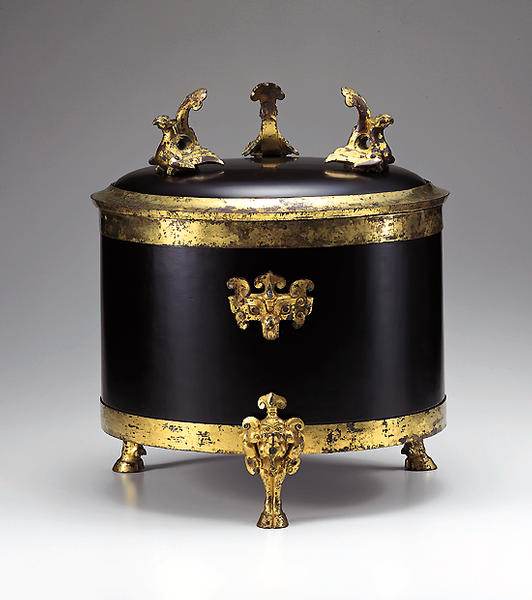円筒容器装飾金具
- 中国
- 中国・前漢時代
- 前206-後9年
- 青銅鍍金
- H-37.1 D-34
この11点の青銅鍍金の部品は、円筒形の容器に付属する装飾金具のセットである。容器の本体は木製漆塗り又は布製であったとみられ、長い間土中に埋もれて朽ちてしまったに違いない。足、口、蓋の環などのサイズからみて、この容器(現在のものは想像による復元)が人目を引く大きさを備えていたことは確かである。中国の至る所の漢墓の浮き彫りに表されているが、恐らく酒を入れる大型の容器(尊)として用いられたのであろう。その中には比較的簡素なものもあるが、他はいずれも動物と奇怪な鬼神を空想的な風景の中に表した、複雑な装飾をもつものである。
Catalogue Entry
The southwestern province of Sichuan has yielded some of the earliest gold artifacts known in China.1 It was also a primary center for lacquer production. By the Han period if not before, these two media converged. In fact, extant marked and inscribed examples suggest that large, imperially administered facilities were producing impressive painted lacquer vessels with gold or gilt bronze fittings or supports in great number from the mid-second century onward.2 Attesting both to the attraction of the wares and the highly developed commercial infrastructure of the time, Sichuan lacquers have been unearthed as far afield as Korea.3
These eleven gilt-bronze fittings represent an almost complete set of ornaments for a cylindrical vessel that no longer exists.4 Probably made of lacquered wood or cloth, the more fragile container must have disintegrated over time in burial. Based upon the size of the foot, mouth, and lid rings, the vessel (now represented in a possible reconstruction) must have been of impressive size. Not a make-up and mirror box (lian), it probably functioned as a large wine container (zun) like those frequently depicted in Han tomb burial reliefs throughout China.5 Based on these depictions as well as the rather large number of excavated examples known in a range of media, the vessel type was extremely popular at the time. Some are relatively plain, but others bear complex decoration, frequently featuring animals and supernatural sprites in fantastic landscapes.6 One can only imagine that the vessel for the Shumei mounts was similarly ornamented, with polychrome patterns surrounding the rich, gilt fittings.
The unusual vessel legs, like those in catalogue number 100, include creatures that resemble those found on a pair of gilt and silvered bronze coffin handles from the tomb of Liu Sheng (d. 113 B.C.). That tomb also included a gilt bronze mask handle like those in these mounts as well as the remnants of a lacquer vessel of similar size with silver and bronze ornaments, suggesting that these beautiful fittings were likewise made during the Western Han period.7
JKW
1. Gold objects as well as gold-leafed sculptures, found at Sanxingdui, are datable to about 1200-1000 B.C. (see Wenwu 1987.10, pp. 16-17, pl. 1.
2. See Wang 1982, pp. 80-99.
3. See, for example, Choson koseki kenkyukai 1934.
4. The spouts of the masked handles probably originally held small gilt bronze loops that are now missing.
5. For Sichuan examples see Gao 1987, nos. 39, 42.
6. For a cast bronze version with quite similar fittings see Zhongguo Renmin Gonghequo 1973, pl. 84.
7. See Hebei sheng 1980, vol. 1, pp. 146-49, 196, vol. 2, pl. 134.1.
